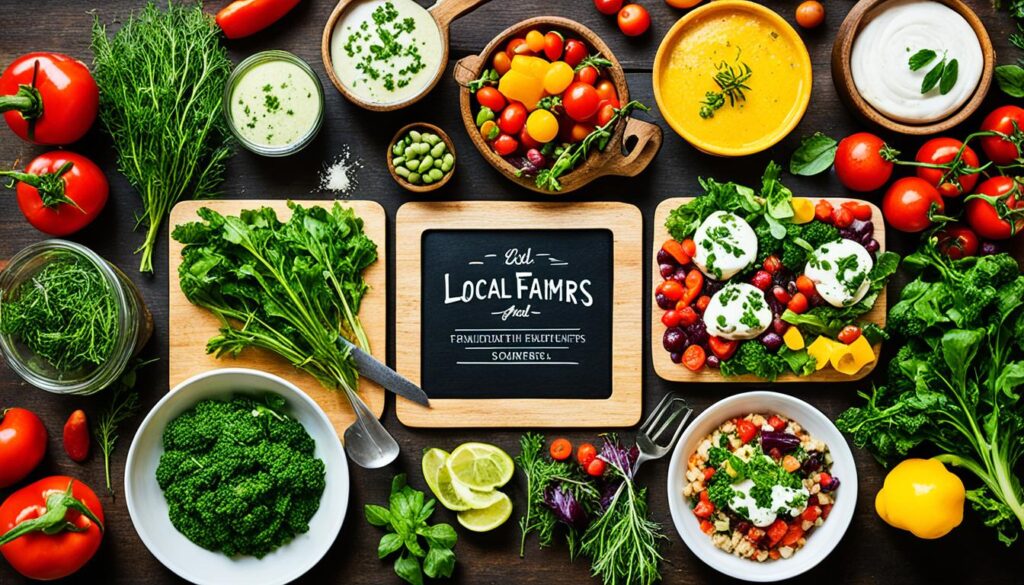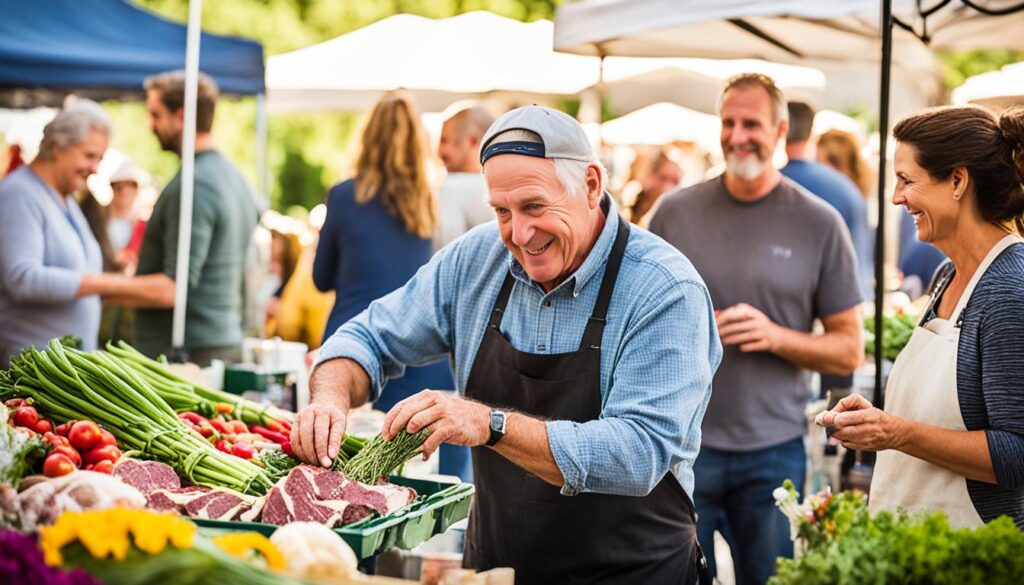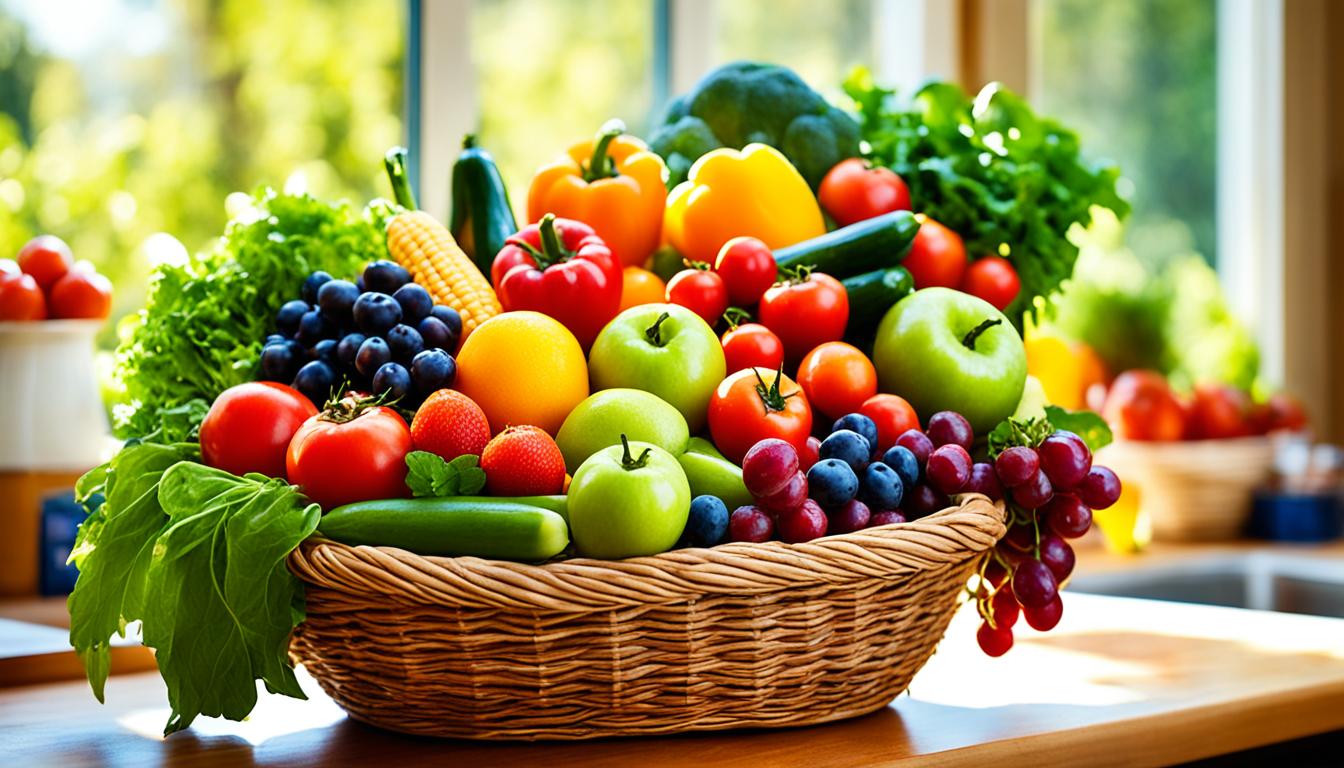Imagine making tasty, healthy meals from ingredients right in your neighborhood. This is the magic of using locally sourced items. We will show you the benefits of this method and how it leads to enjoying fresh, sustainable meals.
Think of a world where the best time to get food aligns with when you cook. Here, using local ingredients makes every meal better. You’ll find recipes like butternut squash lasagna and basil blackberry apple crumble.1
Choosing local ingredients does more than just change what’s on your plate. It also helps your body, supports local farmers, and lessens harm to the planet.2
Key Takeaways
- Locally sourced ingredients provide the foundation for delicious, nutrient-dense meals.
- Embracing the locavore movement and regional cuisines can create balanced, satisfying dishes.
- Eating local supports local farmers and economies while reducing the environmental impact of food transportation.
- A wide range of farm-fresh produce, artisanal foods, and small-batch products are available locally.
- Seasonal eating ensures produce is harvested at the peak of ripeness, enhancing flavor and nutrition.
The Benefits of Eating Local
Eating food from nearby has many pluses. It’s often packed with more nutrients and tastes better than items traveling long distances.3 This choice also helps the local economy and cuts down on pollution from shipping.4
Nutrient-Dense and Flavorful
Food grown close to you is picked fresh, usually within a day of reaching your table.3 In comparison, food from far away loses some nutrients during its journey and storage.3 So, the food closer to you is not only fresher but more nutritious too.4
Supporting Local Farmers and Economies
Buying local supports the people and businesses around you.3 It boosts the local job market and the community’s income.4 Plus, you can get to know the farmers who grow your food and how they do it.3 This makes your food experience richer and you’ll value it more.4
Reducing Food Miles and Environmental Impact
Choosing local means less gas and pollution used to ship food.3 It’s a healthier choice for the planet because the food travels shorter distances.4 It also makes the food supply chain shorter, which is better for everyone.3
Getting food from nearby helps in many ways. It tastes better, is more nutritious, and supports a healthier planet.4
Embracing the Locavore Movement
The locavore movement tells us to eat foods grown or made locally, usually within 100 miles.5 This means meals reflect where we live, with tastes unique to each area. Eating this way comes with health and environmental benefits.
Understanding Seasonal Eating
Eating what’s in season is important to locavores.5 It means our food is at its best, nutrition-wise and taste-wise. This choice also means less pollution from moving food long distances.5 Cooking with local ingredients means our meals are better for us and for the planet.
Connecting with Regional Cuisine
The locavore movement also gets us to know and love our area’s food traditions.6 It encourages finding ingredients close by, from places like farms, small producers, and unique makers. This way, dishes show off the flavors and cultural background of the region, giving people a true local experience.
Learning about seasonal and local foods connects us to our community’s food culture, the heart of the locavore idea. It lets us cook meals that not only satisfy but also bring joy, highlighting the best of where we live.
Locally Sourced Ingredients
The locavore movement is all about enjoying what’s nearby. It shines a light on the many locally sourced ingredients you can find in your community. These include a variety of farm-fresh produce like fruits, veggies, and greens. They bring the distinct tastes and customs of each area to our plates.7
This movement isn’t just about fruits and veggies. It also includes artisanal foods and small-batch production. Think handmade cheese, fresh bread, and special condiments. These items add depth to our meals and support local makers.7
Farm-Fresh Produce
The locavore movement loves fresh options straight from the farm. Picking up food from local markets means it’s at its best – in taste and health.7 This direct relationship shortens the food’s journey to our tables. That keeps the food’s natural benefits intact.8
Artisanal Foods and Small-Batch Production
It’s not just about the farm-fresh stuff. Locavores also root for unique artisanal foods. This includes everything from homemade cheese to special spreads. They reflect the area’s food culture and provide top-quality.7
This approach helps local businesses and delivers real, local flavor.7
| Benefits of Locally Sourced Ingredients | Challenges of Locally Sourced Ingredients |
|---|---|
|
Planning a Local Menu

Crafting a menu with local ingredients means looking at what nearby farms and markets offer.1 It’s about knowing what’s in season and the special taste of local foods. This helps chefs and home cooks make meals that bring out the region’s flavors.1 Using local items can make meal planning more fun. The food ends up being tasty and good for you.
Researching Local Food Producers
Finding local food is key through farmers’ markets, CSA programs, or contacting farms directly.9 This hands-on way helps them see all the fresh produce and unique goods nearby.1 Building connections with local producers helps learn when things are in season, how they’re grown, and the stories behind foods.
Creating Balanced and Satisfying Meals
Knowing about local sources lets cooks start making wholesome and yummy meals.1 Local food is mainly unprocessed and full of nutrients, making it perfect for meals.1 A mix of fresh produce, good proteins, and special additions makes a menu rich in flavor and variety.
Planning a local menu is a great chance to try new recipes and appreciate local food more.1 Embracing what’s in season and available locally leads to exciting dishes. Chefs and cooks might find new ways to combine flavors and make meals that really represent their area.
Delicious Local Meal Ideas
Using local ingredients can lead to tasty meals. For example, a10 butternut squash lasagna with homemade ricotta is hearty. Or try a neighborhood tart with local mushrooms and goat cheese,10 which is rich and flavorful. There are many delicious options when cooking with fresh, locally-produced foods.
Butternut Squash Lasagna with Homemade Ricotta
This butternut squash lasagna is perfect for fall. It’s filled with the sweetness of local squash and the creaminess of homemade ricotta. It’s a wonderful dish for the season.
Neighborhood Tart with Local Mushrooms and Goat Cheese
Make a tart that highlights local mushrooms and goat cheese. This dish brings the tastes of fall to your table. Your whole neighborhood will love it.
Vegetarian Southern Brunch
Enjoy a delicious vegetarian Southern brunch. It’s full of local veggies and baked goods. This menu shows off the best flavors of the area.
Carrot Tomato Soup and Homemade Bread
Try a warming carrot tomato soup with local produce. Enjoy it with homemade bread. This meal is simple but really highlights local ingredients.
Homemade Pasta and Pumpkin Ravioli
Make homemade pasta and pumpkin ravioli with local pumpkins. This dish is full of fall flavors. It’s a great way to showcase local produce in a meal.
Cooking with Locally Sourced Ingredients
Using ingredients from nearby sources can lead to tasty meals. Dishes like zucchini and arugula soup or pork chops with sage and coriander show off local flavors well. They bring out the true potential of locally grown food.2
Zucchini and Arugula Soup
Enjoy summer’s treasures with a healthy zucchini and arugula soup. It blends the earthy note of zucchini with arugula’s peppery taste. Top it with good olive oil and feta for a great starter.
Pork Chops with Fresh Sage and Coriander
Farm-fresh pork chops are perfect for a tasty dinner. Season them with sage and coriander, then pan-fry to a beautiful sear. Add roasted vegetables for a filling meal.
Peach Puff Pastry Tart
Delight in a peach puff pastry tart, a real summer treat. It stars juicy peaches in a flaky pastry, topped with caramel. This dessert captures the essence of sweet, colorful summer fruits.
Locavore Beef Ragu
A beef ragu made with local ingredients is truly heartwarming. It’s simmered with care using beef, tomatoes, and fresh herbs. This sauce, over homemade noodles, honors local food traditions with rich flavors.2
Sweet Potato and Apple Mash with Chipotle and Sage
Make your meal special with a sweet potato and apple mash. It’s spiced with chipotle for warmth and sage for an earthy touch. This dish shines with the goodness of local produce, making any meal better.
Sustainable Dining Experiences
Many people now look for places that offer sustainable dining. This has created more farm-to-table restaurants. These places get their food directly from local farms. This means the food is very fresh and it helps the local community.11
Farm-to-Table Restaurants
Farm-to-table restaurants are getting more love. They focus on using food from nearby sources. Some have their own gardens. Others work with local farmers to get fresh food. This helps the environment by cutting down on food miles.12
It also means the food is unique to that area, showing off its special flavors.11
On-Site Gardens and Local Sourcing
Some places grow many of their own ingredients. They do this with on-site gardens or by working closely with local producers. This way, they can offer a menu that’s all about what’s close by.12 It’s called a “zero-kilometer menu” because nothing comes from far away. This keeps the food fresh, supports local businesses, and lowers the environmental harm of shipping food long distances.11
Educational Opportunities and Foraging
Sustainable places want to teach their visitors about local food and the environment. They explain how their food choices affect the planet. Some places let diners go out and find food themselves. This is called foraging. It lets people pick wild food to eat, getting them closer to nature and local food traditions.1211
Building a Local Food Community

To build a local food community, people can support CSAs, shop at farmers’ markets, and be part of food cooperatives.13 CSAs connect consumers straight to farmers. Markets and co-ops offer tons of local items. By taking part in these activities, you help your local food system and know where your food comes from.
Supporting Community-Supported Agriculture (CSA)
CSA programs let you get to know local farmers and get fresh, seasonal food.13 When you sign up, you’ll get a box with fruits, veggies, and maybe eggs, meat, or dairy, all from the farm.14 This helps the farmers, cuts down on how far food travels, and gets you healthy food right when it’s best.
Shopping at Farmers’ Markets
At farmers’ markets, you can see and buy what’s fresh from local growers.13 Getting your food there lets you meet the farmers who grow it, which makes you value local food more.13 It’s also a place for small food makers to show and sell their unique items, helping the local food group even more.
Joining Local Food Cooperatives
Food co-ops are places where members can get all kinds of local foods, from fresh produce to meat, dairy, and special items.13 Being part of one offers you good, Earth-friendly food while helping your community’s economy.13 These places focus on involving the community, teaching about food, and protecting the environment, all to advance local food efforts.
Conclusion
Locally sourced ingredients support fresh, flavorful, and nutritious meals. When we choose to buy local foods, we help reduce the impact of transporting food over long distances15. This choice also helps our local economies16. By using farm-fresh produce and artisanal items, our food choices become limitless.
Buying ingredients locally makes our meals tastier and healthier15. It also connects us with our community and Mother Earth.15 Talking to local farmers and producers can teach us about our food’s origins. Plus, it supports smaller farms and agriculture.
In the end, choosing locally sourced ingredients is good for us and our neighbors. There are many ways to get involved, from local farmers’ markets to food cooperatives. Joining these efforts means enjoying meals that are fresh and full of taste.16
FAQ
What are the benefits of eating locally sourced ingredients?
Eating locally sourced food is great for several reasons. You get more vitamins and taste in your meals. It helps local farmers and economies too. Plus, it cuts down on the pollution from moving food long distances.
How can I embrace the locavore movement?
To join the locavore movement, start by using what’s in season. Try cooking dishes that highlight your area’s food. This way, you support local flavors and traditions.
What types of locally sourced ingredients are available?
There’s a lot you can find locally. Think about fresh fruits, veggies, and herbs. You can also get handmade items like cheese, meats, and unique sauces.
How can I plan a menu featuring locally sourced ingredients?
To plan a local menu, look at what’s being grown close by. Shop at local markets to see what’s fresh now. This way, your meals will showcase the best of your region.
What are some examples of delicious meals made with locally sourced ingredients?
There are many tasty meals you can cook with local foods. Imagine a rich lasagna made with fresh ricotta. Or a tart that celebrates local mushrooms and cheese. For breakfast, enjoy a Southern variety or homemade soup and bread for lunch. You can also make your own pasta, like flavorful ravioli.
How can I build a local food community?
To strengthen your local food scene, take part in CSA programs. Visit farmers’ markets often. Also, look into joining or supporting food cooperatives. This can help connect you with others who enjoy local foods.
Source Links
- https://makegathergrow.com/blog/local-meal-ideas
- https://feastbozeman.com/the-power-of-locally-sourced-ingredients-and-local-food
- https://www.canr.msu.edu/news/7_benefits_of_eating_local_foods
- https://www.healthline.com/nutrition/why-eat-local-food
- https://sustaineda.org/2017/10/07/5-reasons-to-join-the-locavore-movement/
- https://www.tomsfeast.com/news/locavore-a-person-who-eats-locally-produced-food/
- https://blog.revelsystems.com/locally-sourced-ingredients
- https://gallapark.com/expertly-curated-exquisitely-paired-why-we-use-locally-sourced-ingredients/
- https://get.grubhub.com/blog/locally-sourced-food/
- https://www.hitchcockfarms.com/blog/farm-to-table-menu-ideas
- https://foodfireknives.com/sustainable-dining-experience/
- https://www.insightvacations.com/blog/eco-friendly-restaurants/
- https://www.thisisitbbq.com/from-farm-to-fork-cultivating-connections-flavor-and-community
- https://feastbozeman.com/the-power-of-locally-sourced-ingredients-and-local-food/
- https://meetandeatsac.com/from-farm-to-table-the-importance-of-locally-sourced-ingredients-at-meet-eat/
- https://www.eatnakedfarmer.com/stories/why-locally-sourced-food-matters

